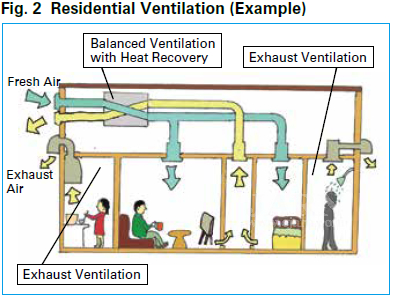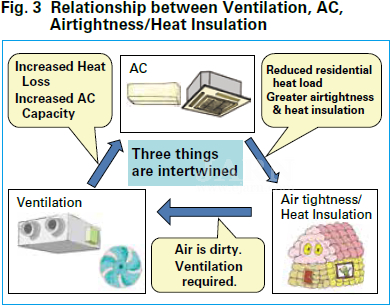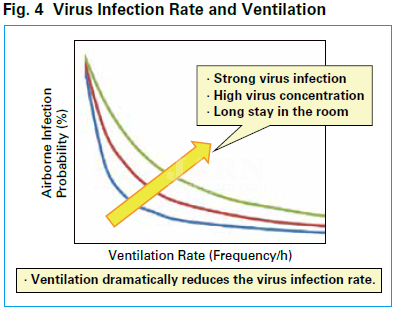Ventilation is the exchange of the inside and outside air of buildings and reduces the concentration of air pollution indoors to maintain human health. Its performance is expressed in terms of ventilation volume, ventilation rate, ventilation frequency, etc.
Contaminants generated in or brought into rooms include CO2, cigarette smoke, dust, chemicals such as building materials, sprays, deodorants, and adhesives, and also mold, mites, and viruses. Meanwhile, outdoor air pollutants include exhaust gas, pollen, PM 2.5 that is particulate matter with diameters of up to 2.5 micrometers, smoke, yellow sand, sulfite gas, etc. Ventilation is performed on the premise that the outside air is not contaminated. When the outside air contains pollutants, it must be decided whether or not to ventilate.
There are three basic factors governing the ventilation of buildings: the amount of outside air, the quality of the outside air, and the direction of airflow. Corresponding to these three basic factors, the ventilation performance of buildings can be evaluated from the following four aspects: 1) A sufficient ventilation rate is provided; 2) The overall indoor airflow direction moves from the clean zone to the dirty zone; 3) The outside air is blown efficiently; and 4) The indoor pollutants are effectively removed.
Natural ventilation is ventilation by air entering/exhausting through gaps, windows, and intake/exhaust ports of buildings, and is greatly affected by the wind outside.
To meet standards for ventilation in each country and region, mechanical ventilation is required in addition to natural ventilation.
Mechanical ventilation is ventilation by fan systems, and the methods used are the balanced method, balanced ventilation with heat recovery method, the exhaust method, and the supply method.
Balanced ventilation supplies and exhausts air simultaneously using fan systems, making it possible to perform planned ventilation, which is its advantage. Balanced ventilation with heat recovery is easy to achieve by adding a heat exchange function, and many housing manufacturers adopt this method.
Exhaust ventilation uses fan systems to exhaust air and uses natural air supply from air ports, gaps, etc. This method is often used in ordinary houses. In particular, it is used for toilets and kitchens that generate air pollution, odors, and smoke.
Supply ventilation uses fan systems to supply air and uses natural air exhaust via air ports, gaps, etc. Supply ventilation is used in spaces where dirty air does not enter, for example in clean rooms, hospitals, factories, and halls.
An example of residential ventilation is shown in Fig. 2.
Mechanical ventilation requires design guidelines that take into account all aspects of careful design, rigorous system maintenance, strict standards, and indoor environmental quality and energy efficiency.
Ventilation, Air Conditioning, Airtightness/Insulation
People use air conditioning to achieve an environment with a comfortable temperature and humidity. In order to save energy for air conditioning from the viewpoint of preventing global warming, airtightness and heat insulation of buildings, both of which reduce ventilation loss and heat loss, are being promoted. However, in highly airtight and highly insulated buildings, ventilation becomes poor and the air tends to become dirty, so mechanical ventilation is required.
In this way, air conditioners, airtightness and heat insulation of buildings, and ventilation are intertwined as shown in Fig. 3. It would be currently recommended to combine highly efficient air conditioners, a highly airtight and highly insulated building, and balanced ventilation with heat recovery. However, since the cost of realizing this combination is high, it is necessary to integrate the above-mentioned three factors, with consideration of the priority according to the time, place, and situation. It is also important to research and develop systems that effectively use natural ventilation. A lifestyle that makes good use of natural ventilation may be important.
Ventilation as a Virus Countermeasure
Among various recommended measures against infectious diseases in recent years, ventilation is reportedly a most effective measure to dilute the virus concentration indoors. Many results have been reported following simulation of the effects of ventilation on the infection probability of a non-infected person in a room with an infected person. The relationship between virus infection rate and ventilation is shown.
in Fig. 4 Although there are changes depending on the infectivity and concentration of the virus in the room as well as the time the non-infected person stays in the room, the age, the physical condition, and with or without a mask, the infection rate decreases as the ventilation rate increases. Ventilation provides a strong defense against viruses.
Ventilation-related Industry Trends
As mentioned above, regular ventilation is required to prevent infection in confined spaces, and this factor is stimulating the ventilation-related industry. Holtop as the leading manufacturer of ventilation system provides several ventilators. For more products informaiton, please click this link to learn more: https://www.airwoods.com/heat-recovery-ventilator/
The demand for CO2 monitoring sensors is also increasing because the spatial concentration of CO2 emitted by human breath is regarded as an effective standard for ventilation. Many CO2 monitoring sensors have been released, and products and systems that use them to monitor the CO2 concentration in the space and link the ventilation systems have been launched on the market. Holtop has been released CO2 monitor which could connect with heat recovery ventilators as well.
Products that combine air conditioners and ventilation systems and CO2 concentration monitoring systems have begun to be used in many facilities such as offices, hospitals, care facilities, halls, and factories. These are becoming essential items for new buildings and facilities.
For more information, please view:https://www.ejarn.com/detail.php?id=72172
Post time: Jun-27-2022




